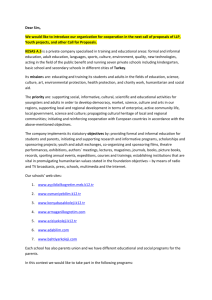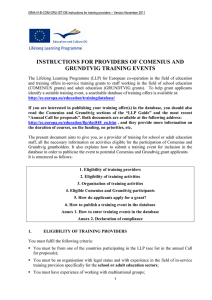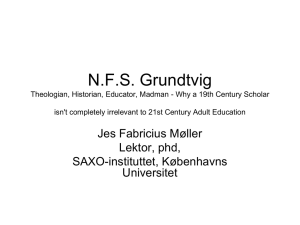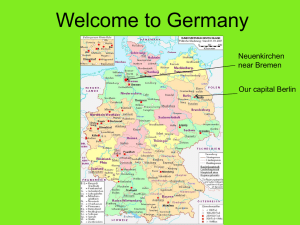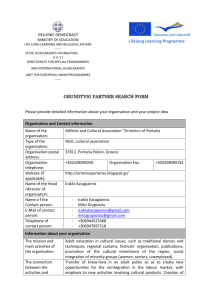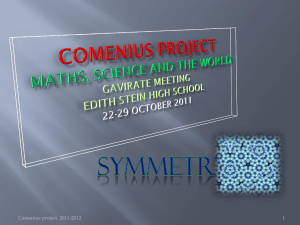Instructions for training providers
advertisement
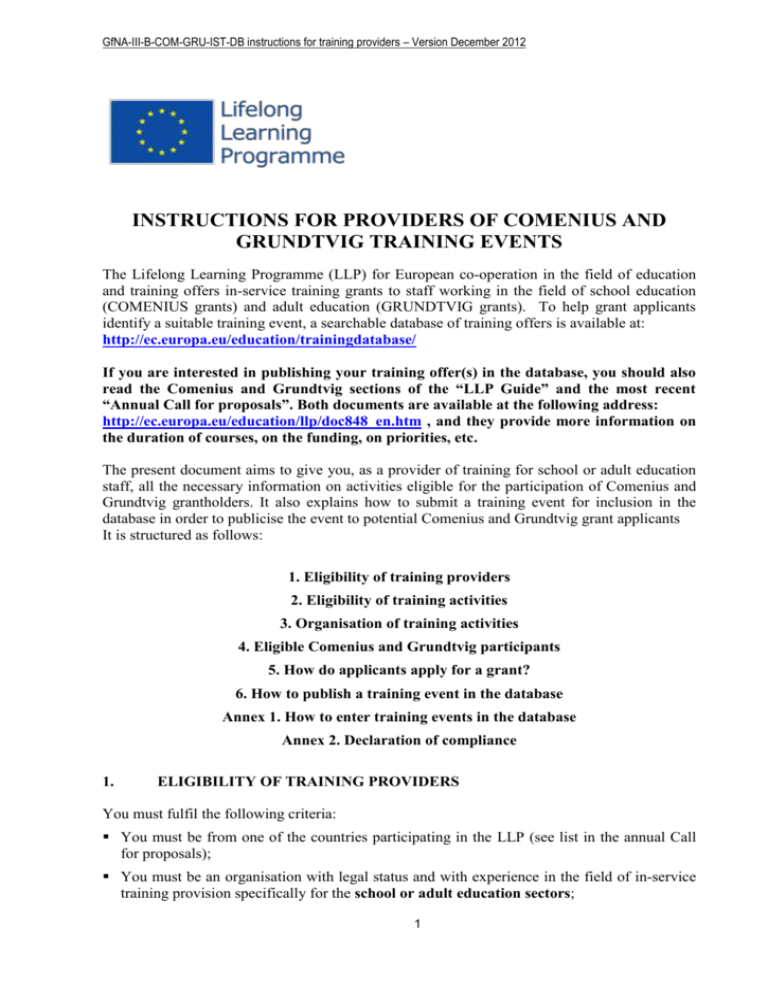
GfNA-III-B-COM-GRU-IST-DB instructions for training providers – Version December 2012 INSTRUCTIONS FOR PROVIDERS OF COMENIUS AND GRUNDTVIG TRAINING EVENTS The Lifelong Learning Programme (LLP) for European co-operation in the field of education and training offers in-service training grants to staff working in the field of school education (COMENIUS grants) and adult education (GRUNDTVIG grants). To help grant applicants identify a suitable training event, a searchable database of training offers is available at: http://ec.europa.eu/education/trainingdatabase/ If you are interested in publishing your training offer(s) in the database, you should also read the Comenius and Grundtvig sections of the “LLP Guide” and the most recent “Annual Call for proposals”. Both documents are available at the following address: http://ec.europa.eu/education/llp/doc848_en.htm , and they provide more information on the duration of courses, on the funding, on priorities, etc. The present document aims to give you, as a provider of training for school or adult education staff, all the necessary information on activities eligible for the participation of Comenius and Grundtvig grantholders. It also explains how to submit a training event for inclusion in the database in order to publicise the event to potential Comenius and Grundtvig grant applicants It is structured as follows: 1. Eligibility of training providers 2. Eligibility of training activities 3. Organisation of training activities 4. Eligible Comenius and Grundtvig participants 5. How do applicants apply for a grant? 6. How to publish a training event in the database Annex 1. How to enter training events in the database Annex 2. Declaration of compliance 1. ELIGIBILITY OF TRAINING PROVIDERS You must fulfil the following criteria: You must be from one of the countries participating in the LLP (see list in the annual Call for proposals); You must be an organisation with legal status and with experience in the field of in-service training provision specifically for the school or adult education sectors; 1 GfNA-III-B-COM-GRU-IST-DB instructions for training providers – Version December 2012 You must have experience of working with multinational groups; You must have the financial and technical capacity to successfully offer the proposed training activities. In case of doubt about your capacity to organise the proposed training activity, the National Agency may require additional information such as a copy of your organisation’s statutes, its activity or financial report of previous years, or the CVs of individual trainers, for example. 2. ELIGIBILITY OF TRAINING ACTIVITIES In order for a training event to be published in the database and considered eligible for participation by a Comenius or Grundtvig grantholder, it must meet the criteria listed below. You should note that inclusion of an event in the database has no direct funding implications and does not guarantee full attendance at courses. LLP National Agencies are responsible for assessing and selecting individual grant applications. You should also note that only training activities resulting from projects or networks of the LLP or its predecessor programmes (Socrates and Leonardo da Vinci) are eligible for publishing in the database for the attention of potential Comenius (school education) grantholders. In contrast, all activities meeting the criteria below may be published for the attention of potential Grundtvig (adult education) grantholders. Type of training: The training may take the form of: - A structured course for adult or school education staff with a strong European focus in terms of subject matter and profile of trainers and participants lasting at least 5 working days. - More informal training such as a placement, observation period, job shadowing, teaching visit or exchange (depending on the programme) in a school or in a relevant organisation involved in school education (e.g. NGO, public authority), in an adult education organisation or a public or non-governmental organisation involved in adult education. - Participation in a European conference or seminar organised by a former or ongoing Comenius or Grundtvig Multilateral Network, Multilateral Project or Accompanying Measures Project, by a National Agency, or by a genuinely representative European association active in the field of school or adult education (excluding Comenius and Grundtvig Contact Seminars) . Content: Eligible training activities must concentrate on providing participants with practical teaching skills, techniques, methodologies or skills related to management of learning. Also eligible is training concerned with, for example: - the management of schools or adult education institutions/organisations - the system/policy related aspects of school or adult education - the teaching of European integration - the teaching of the eight key competences for lifelong learning - gender education - intercultural education (e.g. teaching of anti-racism, education of migrant workers, Roma, travellers, occupational travellers) 2 GfNA-III-B-COM-GRU-IST-DB instructions for training providers – Version December 2012 The content should in all cases be specifically targeted towards education staff (see section 4 below on eligible Comenius and Grundtvig groups). The objectives and methodology sections of the training description form should make clear how the training is targeted towards these groups. Language training: Language training should provide teachers with learning and teaching methodologies; only in a few cases are “pure language” courses eligible for a Comenius or Grundtvig grant. This is the case for: training in the less widely taught and less used languages1, staff teaching non-language subjects through a foreign language; staff retraining as a foreign language teacher; staff participating in a Comenius or Grundtvig Partnership who request training in a Partnership language and Comenius Individual Pupil Mobility mentors and contact teachers who request training in a language necessary for implementing the pupil mobilities. Location: The training must be delivered in one of the countries participating in the LLP Programme (see list in the LLP Guide). Duration: - A structured course should last at least 5 working days (excluding travel time). Other types of training activities might be shorter. - The maximum duration of the IST event is 6 weeks; for Grundtvig Visits and Exchanges it is 90 days Trainers: The training team should be multinational and have significant experience of more than one European education system. The requirement for a multinational training team does not apply to courses with a significant language content aimed at language teachers. Participants: In the training description form, you must clearly identify the target group/s (Comenius or Grundtvig) for the event. You may recruit participants from any source you wish, but must make every effort to ensure that trainees, with the exception of individual training such as job shadowing, come from at least three countries participating in the LLP. It is recommended that one nationality should constitute maximum 30% of all participants of the course. Working with other participants in a multinational group is an important feature of the European training experience. Language: You must provide the training in one (or more) of the 23 official European Union languages (Luxembourgish and Irish are also eligible when the training concerns these languages) and give participants training and information materials in at least one of these languages. However, it is highly recommended that materials be provided in a variety of languages to ensure maximum dissemination and use. Evaluation: You must include a final evaluation session at the end of the training activities, so that participants can report their opinion on the quality of the training. You are also advised to organise interim evaluation sessions throughout the training event, if relevant. 1 These are defined with reference to how widely taught any language is (with the exception of English) within a given participating country. 3 GfNA-III-B-COM-GRU-IST-DB instructions for training providers – Version December 2012 Certification of attendance: You must certify attendance at the training activity by certificate or otherwise. The certificate should be provided at the end of the training activity and it should clearly specify the name of the participant, dates of the activity and the training content followed by the participant. The certification document needs to be signed by the course provider. In some countries, education authorities take this certificate into account for the purposes of the participant’s career development, salary, etc. You are highly recommended to use a standard European document, the Europass Mobility. For more information on Europass Mobility certificate and examples of the documents, please consult the website: http://europass.cedefop.europa.eu 3. ORGANISATION OF TRAINING ACTIVITIES Venue facilities: With a view to equal opportunities for all potential participants, you should ensure that appropriate measures are taken and facilities provided to allow full participation by ethnic and religious minorities and those with special needs. Date: To maximise attendance at your course/conference you are advised to harmonise the date of the training activity with the common European application deadlines and the eligible training periods. The current application deadlines are defined in the annual Call and in the selection timetable, which can be found on the Database homepage: http://ec.europa.eu/education/trainingdatabase/search.cfm Participation costs: Costs may be of two types: (1) a fee for tuition and materials up to a maximum amount of 150- € per day (European maximum), (2) subsistence costs for participants (including costs of accommodation). You need to make a clear distinction between these two types of costs, as the participants are granted a separate amount for the course fee (tuition + materials) and a separate amount for subsistence. Please, note that National Agencies apply different rates and some can set up lower ceilings on the course fee. Information about the applied ceilings is provided on the website of the relevant National Agency. (Link to the website with the LLP National Agencies is specified in point 6 of the Annex to these Instructions). The prices published in the database are binding maxima and they cannot be increased. The trainees apply for the grant on the basis of this information in the database, and the allocated grant cannot be increased after the award decision has been made. You may not ask Comenius or Grundtvig grantholders for any pre-registration fees. Preparation and follow-up phases: You must provide participants with a suitable predeparture programme (e.g. suggested reading material, support documents, questionnaires etc). After the training, you must provide a range of follow-up activities which will allow participants to get maximum benefit from the training (e.g. distance learning activities, email contacts with trainers, self-evaluation of lessons taught after the training event, peer networking, etc). (Course evaluation is not a follow-up activity.) 4 GfNA-III-B-COM-GRU-IST-DB instructions for training providers – Version December 2012 Special needs: It is important that you describe all the available provisions for participants with special needs (disabled, dietary, religious, ethnic, childcare needs, etc.). Cancellation: You should clearly inform potential participants of the final date for confirmation of attendance. Comenius and Grundtvig grantholders may not use grant funds to cover costs arising from cancellation of their attendance unless this is due to force majeure (certified serious illness or death of a close relative only). If relevant, cancellation rules should be clearly described in the database course description form. If you cancel the course and the beneficiary has already paid any fees to you, you should promptly reimburse the whole amount to the beneficiary. Disputes: At no stage will the European Commission intervene in any disagreement between course participants, course organisers and/or National Agencies or in any other matter relating to the operational aspects of the management of courses advertised in the database. 4. ELIGIBLE COMENIUS AND GRUNDTVIG CANDIDATES COMENIUS GRUNDTVIG * School education staff (teaching and non- * Staff working in any sector of adult education, including: teaching), including: Teachers/trainers in adult education and the teachers (including those in pre-school and trainers of such teachers/trainers; vocational education), and the trainers of such teachers; heads and managerial staff of organisations head teachers, school managerial staff; providing adult learning opportunities; staff involved in intercultural adult staff involved in intercultural education or education, or working with migrant groups, working with children of migrant workers travellers, occupational travellers and and travellers; ethnic communities; staff working with pupils with special staff working with adults with special education needs; learning needs; staff working with pupils at risk, such as staff working with adults at risk, for mediators and street educators; example, mediators and street educators; counsellors or career advisors; counsellors or career advisors; the inspectorate; staff in local/regional authorities dealing other education staff at the discretion of with adult education, including the national authorities. inspectorate; Former and unemployed teachers re- persons who can demonstrate a clear entering the profession after a period away intention of working in adult education but from teaching who are currently in some other labour market situations; persons who have completed a qualification * For a PURE LANGUAGE training grant: A school teacher of non-language subjects leading to a career in adult education and through a foreign language; intend to start a career in adult education; 5 GfNA-III-B-COM-GRU-IST-DB instructions for training providers – Version December 2012 A school teacher re-training as a foreign other education staff at the discretion of language teacher; national authorities. A member of school education staff participating in a Comenius Partnership and requesting training in a Partnership language; * For a PURE LANGUAGE training grant: A school teacher requesting training in a An adult education teacher of nonless widely taught and less used language; language subjects through a foreign A primary or pre-primary teacher who is language; (or will be) required to teach foreign A teacher re-training as an adult education languages foreign language teacher; Individual Pupil Mobility mentors and A member of staff participating in a contact teachers requesting training in a Grundtvig Learning Partnership and language necessary for implementing the requesting training in a Partnership pupil mobilities language; A member of adult education staff requesting training in a less widely taught and less used language for teaching purposes. 5. HOW DO APPLICANTS APPLY FOR A GRANT? Any candidate interested in your training event will contact you to express his or her interest and check that places are still available before applying to his LLP National Agency for a Comenius or Grundtvig grant. Applicants for a Grundtvig grant may be required to enclose with their application a confirmation of provisional registration. If the candidate is then awarded a grant by his/her National Agency, s/he will contact you to confirm this and to formally register for the training event. If the candidate has not been awarded a grant, it is his/her responsibility to contact you to cancel any pre-registration which may have been made. You may of course also contact pre-registered candidates yourself to ask them to confirm or cancel their participation. The duration of the selection process differs per each country and it can last between 7 and 10 weeks. This means that the selection results are communicated to the applicants around 2 months after the application deadline at the earliest. From the moment the candidate receives a grant from his/her National Agency and confirms his/her attendance at your training event, s/he has responsibilities towards you, the training provider. If s/he cancels her/his attendance, s/he will be responsible for paying any cancellation fee which you may claim. Only in very exceptional cases of force majeure (e.g. serious illness or death of the candidate or close family member) may his/her National Agency pay cancellation fees using grant funds. If you, the training provider, cancel the training at short notice, you may be asked by the candidate for compensation if s/he has already incurred costs. 6. HOW TO PUBLISH A TRAINING EVENT IN THE DATABASE 6 GfNA-III-B-COM-GRU-IST-DB instructions for training providers – Version December 2012 Annex 1 to this note explains how to complete and submit the training description form for publication of an event in the database. Annex 2 includes the declaration of compliance which must be signed and sent to the relevant National Agency. The training description form and the declaration of compliance should be sent to the National Agency located in the country where the course provider is registered (which can be different from the country where the training event is organised). If the training activity is for both Comenius and Grundtvig grantholders, the training event information should be introduced into the database twice, and the application documents should be sent to both Comenius and Grundtvig Agencies/departments as required at national level. Courses resulting from the Socrates and LLP centralised projects: the application for including in the database the courses resulting from Socrates/LLP centralised projects can be submitted by the project co-ordinator only. The application should be additionally accompanied with the project description. If the project co-ordinator no longer wishes to organise the course, the right to and the responsibility for the course can be transferred to a project partner. The project co-ordinator should notify its NA indicating the new course provider. The co-ordinator's NA should then inform the NA of the new course organiser about the change. The new course organiser applies to the relevant NA. Submission dates: You are encouraged to submit the form as soon as possible and ideally no later than 10 months before the training start date, in order to make training details available to potential participants in good time. Processing the training description form: The National Agency of the institution organising the training will carry out an eligibility check of the proposal in accordance with the criteria described above. If necessary, the NA may require further information from you. Removal from the database: Participants report to their own National Agency after attending a training event. Training which is considered to be of poor quality, receives repeated complaints or does not comply with the declaration of compliance will be further investigated by your National Agency and may be removed from the database. 7 GfNA-III-B-COM-GRU-IST-DB instructions for training providers – Version December 2012 ANNEX 1. HOW TO ENTER TRAINING EVENTS IN THE COMENIUS-GRUNDTVIG DATABASE FOR IN-SERVICE TRAINING GRANTS 1. Start by entering the website http://ec.europa.eu/education/trainingdatabase/ On the website, click on the link "Training description form" under the heading "Training providers". 2. You will be re-directed to ECAS (the "European Commission Authentication Service") 3. If you are a new user, you will have to create a new ECAS account. To do so, click on the link "Sign up for ECAS", and follow the on-screen instructions. Once the account creation process is complete, you will be automatically re-directed to your new account. You can then start to fill in the training description form. Remember your username and password: You will use the same username and password to review the data of this course and to enter any new courses in the database. If you are an existing user, you will have to enter your username and password and click on the "Submit" button. The first screen will show all the courses you have already entered and that are pending being “finalised and submitted” by you, and those that are pending validation by the National Agency of your country. To see the courses you have submitted that have been already validated by the National Agency and published, click on the lock icon in the top blue line. To enter a new course, click on the button ‘add new course’ and fill in the form that will appear organised in 11 sections. You can save the data you have entered (at least the 1st page has to be completed), and leave the database. The partially filled course description form will be saved and will appear in the list of your courses. You will be able to finalise the remaining fields at any moment after entering the database again with your username and password. If you forget or lose your username or password, you may recover them directly from ECAS by following the procedure below: 1) Access the link: https://webgate.ec.europa.eu/cas/ec/init/passwordResetRequest.do?changeDomain=true 2) Select the domain "External" (making sure that the checkbox "remember my domain" is selected), and press the "select" button; 3) Follow the on-screen instructions to regain the password; For further assistance, you should send a message to the following email address: EAC-ISSUPPORT@ec.europa.eu 4. The form must be completed in the main language of tuition of the training. Forms which are incorrectly or incompletely filled in will not be taken into consideration. 8 GfNA-III-B-COM-GRU-IST-DB instructions for training providers – Version December 2012 If several sessions of the same training activity are proposed, only one description form should be completed. You can enter as many sessions as needed by clicking on the button “Add new session dates” at the bottom of section “11. INFORMATION ON COURSE SESSION/S”. In the training description form, please complete all relevant fields, which are divided into the following pages: 1. Institution organising the training 2. Type of training activity 3. Title of training activity 4. Education sector of the training participants 5. Target audience 6. Thematic field of the training 7. Languages used for the training 8. Full description of training contents 9. Programme of the training activities (day by day) 10. Type of certification of attendance awarded 11. Information of course session/s Do not forget to save every page you complete before going to the next. 5. When you have completed the training description form, click on the button ‘Finalise and submit’ to allow validation of this form by your National Agency. If at the stage of finalising you have forgotten to fill in compulsory fields, the system will tell you: ‘All the compulsory fields are not filled in. You have to complete these fields before submission. Please check the incomplete sections. Go back to the form.’ Click on “Go back to the form” and fill in the areas that are in red. Once completed, you should click again on “Finalise & Submit” to submit the form electronically to your National Agency. You also must send to your National Agency a paper copy of the form signed and stamped. After the form is “Finalised and submitted” it cannot be modified. If modifications are needed, before or after validation, please contact your National Agency. 6. With the paper copy of the form you must also send to the National Agency the declaration of compliance, which can be downloaded at the "Print" stage. The declaration must be signed and stamped by the legal representative of the training provider institution. Failing to submit the declaration of compliance or the course description form will prevent the training event from being included in the database. 7. You will receive an automatic email from the database to confirm the submission of the form and then an email from your National Agency which either: - confirms that your course has been validated, and therefore appears in the database; - or informs you that the course has been ‘blocked’ and requests that you revise or complete certain section of the form before re-submitting it to the Agency for validation. The address used to send these messages is the address of the 1st person entered in section “1. INSTITUTION ORGANISING THE TRAINING / ORGANISER/S OF THE TRAINING”. 9 GfNA-III-B-COM-GRU-IST-DB instructions for training providers – Version December 2012 The National Agency that will validate your form is the National Agency of the country entered as organisation in section “1. INSTITUTION ORGANISING THE TRAINING”. 8. Should you need any further information, please contact your National Agency. Contact details can be found at: http://ec.europa.eu/education/programmes/llp/national_en.html 10 GfNA-III-B-COM-GRU-IST-DB instructions for training providers – Version December 2012 Annex 2. DECLARATION OF COMPLIANCE MINIMUM OBLIGATIONS FOR PROVIDERS OF COMENIUS AND GRUNDTVIG TRAINING EVENTS The declaration has to be provided for each training event to be included in the Comenius-Grundtvig Training Database Activity reference number To be filled by the National Agency Title of training Name of training provider I, as the representative of the training provider institution, wish to publicise in the European Comenius and Grundtvig Training Database the above mentioned training event which will be organised according to the minimal requirements defined herein. 1. Training content We offer a training event for adult or school education staff which is in line with the relevant annual Lifelong Learning Programme Call for Proposals; a training event with a strong European dimension in terms of subject matter and profile of trainers which will provide the participants with practical professional skills and knowledge to gain a broader understanding of school or adult education in Europe; a highly qualified multinational team to ensure high quality of the training activity; We provide our participants with a suitable pre-departure programme (e.g. suggested reading material, support documents, questionnaires, etc.); a range of follow-up activities which will allow participants to get maximum benefit from the training (e.g. distance learning activities, self-assessment of lessons taught after training, peer networking); a certificate of attendance of the training activity. The certificate will clearly specify the name of the participant, dates of the activity and the training content followed by the participant, and it will be distributed at the end of the training activity (before participants' departure). If possible, we will use the Europass Mobility certificate. We confirm that where a structured course or a seminar/conference is targeted at Comenius grant holders, it is the result of a previous Socrates project or an LLP Multilateral Project a Network or an Accompanying Measures project. 2. Composition of the group We confirm that the specific target group/s (Comenius or Grundtvig) for the event is clearly specified; the participants should come from at least three countries participating in the LLP; 11 GfNA-III-B-COM-GRU-IST-DB instructions for training providers – Version December 2012 one nationality should normally constitute maximum 30% of all participants of the course, and we will make every effort to reach this target. 3. Organisational aspects We confirm that the training activity is held in a country participating in the LLP (see the list in the annual Call for Proposals); the IST activity can last maximum 6 weeks; a Grundtvig Visits and Exchanges activity can last up to 90 days. a structured course must last at least 5 working days (excluding travel time); other types of training activities might be shorter a detailed day by day programme with clear start and end time of training activities has been provided in the Comenius and Grundtvig Training Database and it corresponds to the training that will be realised; we will not charge the participants any pre-registration fees; in case we need to cancel the training event, we will not charge the participants with any costs and we will reimburse promptly any course fees paid by the participants; we provide detailed rules concerning cancellation. We guarantee free cancellation until 4 weeks before the training; in case we have more than one group per session we provide information on how we build the groups; we organise an evaluation session at the end of the training activity; we guarantee that the information given in the Comenius and Grundtvig Training Database is up to date and binding for the training offered. 4. Training provider institution We declare that our organisation comes from one of the countries participating in the LLP (see the list in the annual Call for Proposals); has a legal status and experience in the field of in-service training provision specifically for the school or adult education sectors; is experienced in working with multinational groups; has the financial and technical capacity to successfully offer the proposed training activities. I, the undersigned, hereby guarantee that our organisation fulfils the above requirements and that we respect the information included in Instructions for providers of Comenius and Grundtvig training events. I recognize that the relevant National Agency may verify if these demands are being fulfilled. Should the training event no longer comply with the rules stated herein, I will inform the National Agency accordingly. In case of breach of the declaration our organisation will be excluded from the Comenius and Grundtvig Training Database. Place: Date: Signature: Name and title (position), in block capitals, of the signatory: Surname: First name: Title (position): Official stamp of the applicant body: 12
